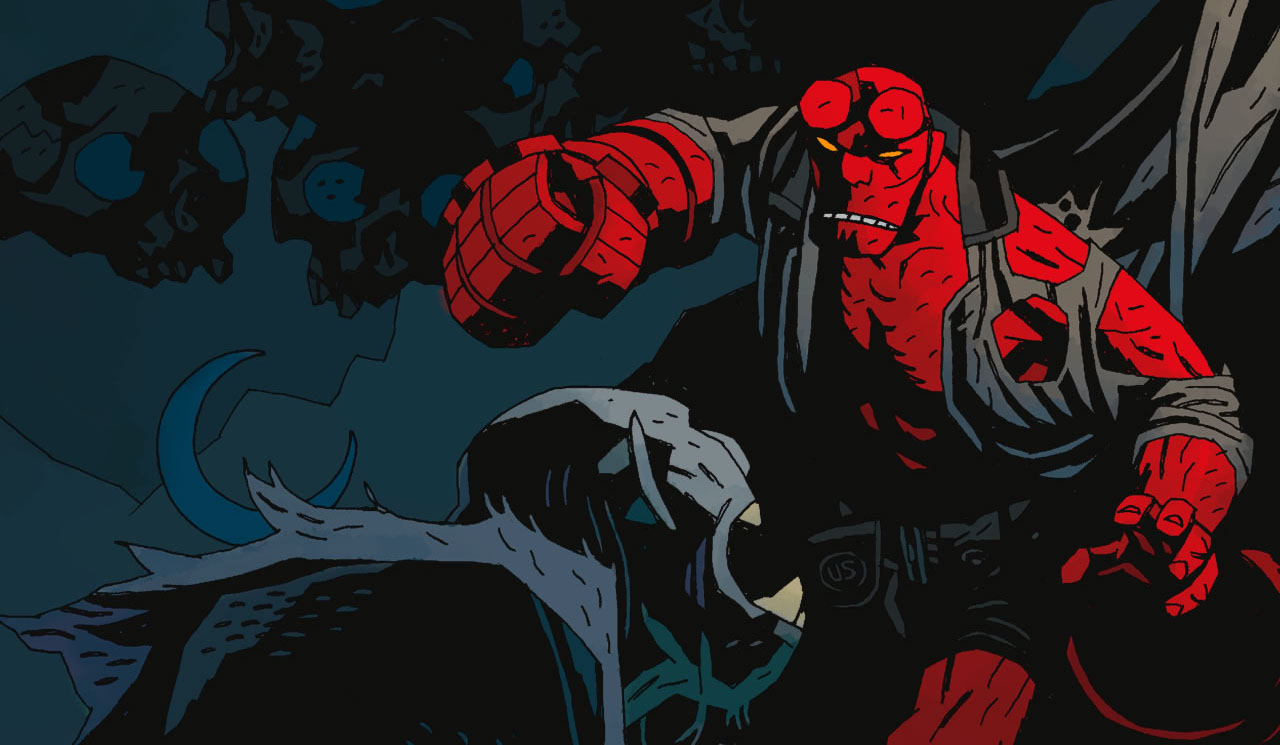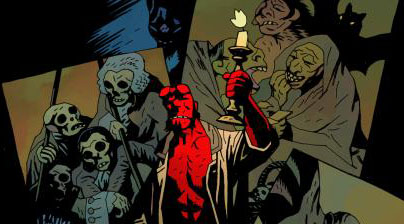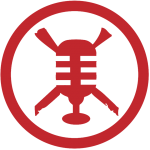
Comics Creepshow 13: Hellboy
There were quite a few books to choose from for this week’s column. First off, you had Steve Niles’ newest mini-series starting up called SAVAGE. I would give you a small description of it, but I couldn’t really tell what the hell was going on in that first issue. A new stand alone story, based on a Frank Frazetta painting called THE SWAMP DEMON, was another possibility, but I have already covered Frazetta inspired comics in this column. I toyed with the idea of reviewing a super hero comic called FINAL CRISIS: RAGE OF THE RED LANTERNS. Even though it was filled with men in brightly colored tights shooting laser beams at each other, there was a hell of a lot of gore and terror, at the same time. That book was a little too closely tied in with events happening at DC comics, so I skipped out on that review as well.
So what did I pick? Well, in the end, I had a personal reason to pick this week’s comic. I chose to review HELLBOY: IN THE CHAPEL OF MOLOCH, since I am dressing up as the big red guy with the massive metal fist, for this Halloween. The Hellboy mask that I will be wearing was made from a mold of actor Ron Perlman’s face. Most of you are probably familiar with the movie version of Hellboy. This is thanks to the vision director Guillermo Del Toro had when he wanted to bring the indie comic character to the big screen. Comic fans, however, especially HELLBOY comic fans, will tell you that even though Guillermo’s ‘Hellboy I’ and ‘Hellboy II’ are visually stunning and entertaining, they are not the best thing the Hellboy franchise has to offer.
HELLBOY has been around since 1991, when artist/writer Mike Mignolia drew him, for the first time, into the program for the Great Salt Lake Comic Convention. From then on, Hellboy has starred in many one shots (single issue comics) and mini-series, made by Dark Horse Comics. Whenever HELLBOY is mentioned on comics podcasts, like ‘Around Comics’ or ‘I-Fanboy’, the commentators always go off on a tangent about how beautiful Mignolia’s artwork is. The same goes for when HELLBOY is reviewed at IGN or Comicbookresources.com.
Mignolia doesn’t draw photo realistic backgrounds, or detailed portraits for each of his characters. His art is not derived from the artwork of Golden Age comic book artists, nor is it influenced by anime. Mignolia has a style all of his own. His characters are basic, almost to the point of being cartoon looking, yet the shading Mignolia uses makes them and the world around them seem both darkly serious and spooky. It seems as if any type of demonic creature can leap out of the shadows at any moment. Mignolia seems an expert at transferring pictures of old ruins and cemeteries into his cartoon world, as well. Guillermo Del Toro’s visual style seemed to cancel this out in the films. The visuals in the ‘Hellboy’ films are amazing, the art in the ‘Hellboy’ comics is even more breathtaking.
Just as the ‘Hellboy’ films have brought attention to the character, yet cancelled out the visuals of the comic, the HELLBOY franchise has brought Mignolia a lot of success, but has taken him away from actually drawing the book. In nearly two decades, HELLBOY has grown into a popular indie phenomenon. Hellboy’s fellow freaks, including Abe Sapien from the first film, and Johann Kraus from the second film, star in their own spin-off series, the B.P.R.D. Mignolia has to keep track of all of these books now, and also any other type of Hellboy related merchandise, from video games to a possible live action television show.

The last time Mignolia drew HELLBOY was way back in 2005, in the story entitled, ‘The Island’. Since then, other creators have both scripted and drawn HELLBOY. This makes HELLBOY: IN THE CHAPEL OF MOLOCH even more of an event, since Mignolia is back on board. Even though the story of this one shot is uneventful, Mignolia’s artwork is just as beautiful as when HELLBOY first came out.
Mignolia, being the main HELLBOY writer, also does an extensive amount of research for each story. The main monsters in each HELLBOY story are taken directly from different forms of mythology, from Celtic, to Russian, to Latin American. Moloch, the title monster of our story is actually from Middle Eastern mythology. According to what Hellboy says, Moloch was “One of the old Middle-Eastern God-Monsters. He’s actually mentioned in the Bible a couple of times.” I looked up Moloch on the Web. That description matches pretty much what I found. But like all HELLBOY monsters, there has to be a nasty catch, though, right? Well, Hellboy continues his explanation of Moloch: “His followers used to sacrifice children to him…They used to build a fire inside of a big brass idol and then roast the kids in his hands.”
So how does Hellboy enter into Moloch’s Chapel in the first place? The whole story is a flashback, taking us to the time before the first HELLBOY miniseries, SEEDS OF DESTRUCTION. At this point, Hellboy is still a member of the B.P.R.D. Hellboy is asked to travel to Tavira, in Southern Portugal, where a man claims that his artist friend is under the influence of a demonic force. They never mention the friend’s name, but he tells Hellboy that the artist’s name is Jerry. It turns out Jerry has been spending a lot of time in the abandoned chapel that is right next to his house. This chapel, also happens to be the place, where a few hundred years ago, a few kiddies were sacrificed to a certain God-Monster, that we mentioned before.
The friend shows Hellboy some of the things Jerry has painted recently. The paintings are filled with all different types of demons. One of these painted demons is based on a real demon, that enters into the chapel, every night, through a hole in the floor. This demon jumps on Jerry’s back and inspires him to paint and sculpt all of the twisted things he can come up with. One of those pieces happens to be a tremendous statue of Moloch, that when Hellboy scrapes it with a chizel, it bleeds.
After Hellboy spots the demon he gets its attention. It jumps off of Jerry and charges at him. Hellboy uses some of his occult know-how (which we only see a little bit of in the two ’Hellboy’ films) and pulls out a special button that causes the demon to burn from the inside.
You can guess what happens next- the statue of Moloch comes to life. Now we see the brutish Hellboy, that was portrayed by Ron Pearlman in the films. He gets into a brawl with the statue. They exchange punches back and forth. Eventually, Hellboy takes out his massive gun and shoots the demonic creation. As he delivers the killing blow to the statue, literally shooting it in its tremendous heart, Jerry shrieks. It turns out his artistic inspiration died with the Moloch statue he created. He whimpers to Hellboy, “I’m ruined. I’ll never paint again.” to which Hellboy responds, “Not the worst news I have ever heard.”
Like I said before, the artwork in this stand alone story is top notch. There is no character development whatsoever, but that is to be expected in a single issue story. One shots are usually used to showcase a certain aspect of a character’s personality. I believe HELLBOY- IN THE CHAPEL OF MOLOCH is a one shot made to show that Mignolia still has a direct attachment to the character. Throughout the story, there are panels devoted to the demonic paintings Jerry has made. These panels are spliced in between the investigation that Hellboy conducts and the fight at the very end of the story. These inter-spliced panels add a whole other dimension to this comic. You get the creepy sensation that there are demons, constantly watching Hellboy, and the things going on in the mortal world. It is the little subtle touches like that, combined with Mignolia’s art and the interesting mythological references that make Hellboy a truly unique horror comic.
It is only $2.99. Maybe you should buy a copy and place it in some lucky trick ‘r treaters bag. Oh and if Hellboy comes by looking for candy, remember he likes Baby Ruths.

